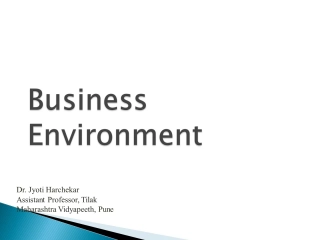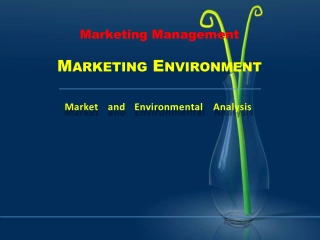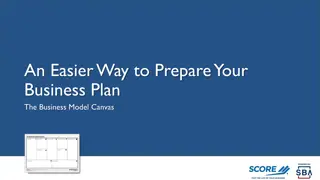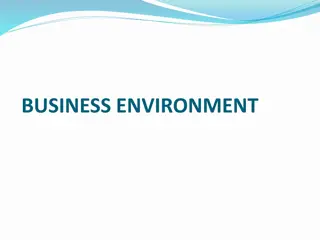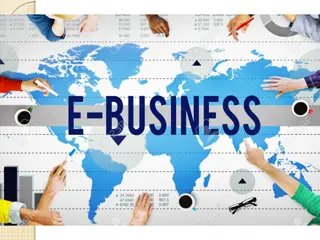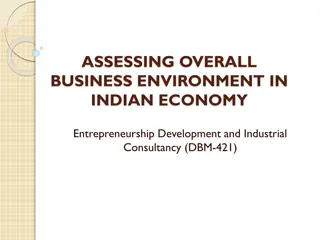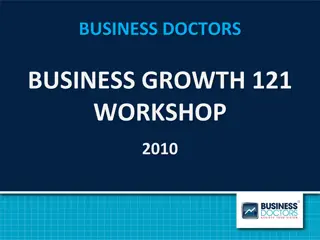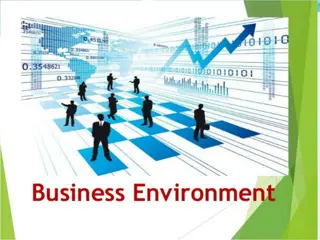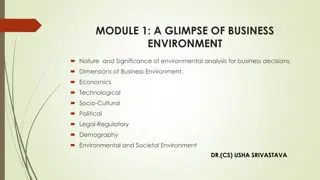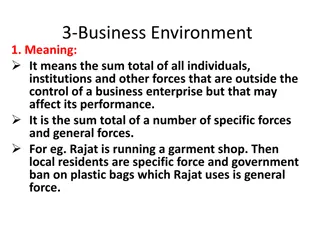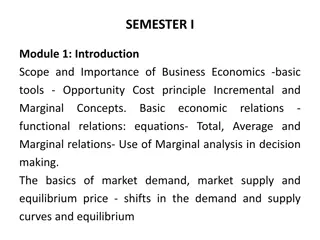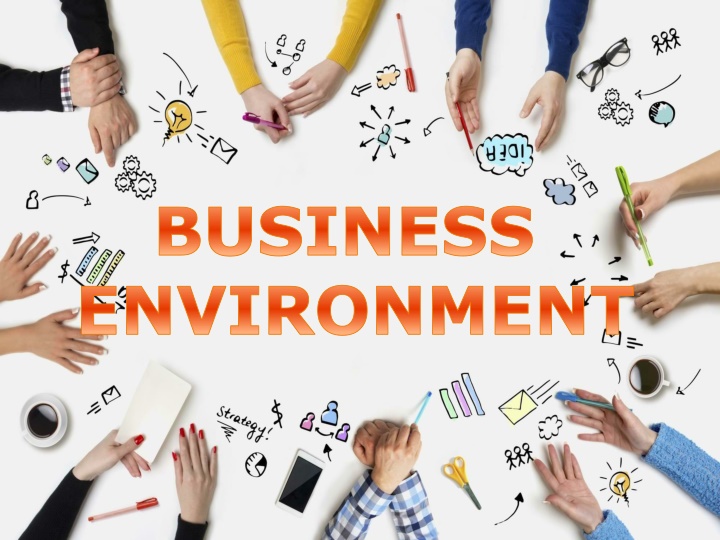
Business: Concepts, Objectives, and Scope
Explore the definition, characteristics, and objectives of business in this comprehensive guide. Learn about the economic, social, and human objectives of businesses, along with the national and global objectives they strive to achieve. Delve into the diverse scope of business, encompassing commerce, industry, trade, and aids to trade. Gain insights into the business environment and the varying sizes of businesses, all united by the common pursuit of profitability.
Download Presentation

Please find below an Image/Link to download the presentation.
The content on the website is provided AS IS for your information and personal use only. It may not be sold, licensed, or shared on other websites without obtaining consent from the author. If you encounter any issues during the download, it is possible that the publisher has removed the file from their server.
You are allowed to download the files provided on this website for personal or commercial use, subject to the condition that they are used lawfully. All files are the property of their respective owners.
The content on the website is provided AS IS for your information and personal use only. It may not be sold, licensed, or shared on other websites without obtaining consent from the author.
E N D
Presentation Transcript
BUSINESS ENVIRONMENT
CHAPTER 1 BUSINESS
Definition of Business Business activities are all those human activities which are directed towards the production and procuring of wealth. - Prof. Haney
CHARACTERISTICS OF BUSINESS Deals in goods and services Two parties Continuous process Profit motive Monetary exchange Involves risk and uncertainty Involves production and distribution
OBJECTIVES OF BUSINESS ECONOMIC OBJECTIVES Creation of customers Continuous Innovations Best possible use of resources SOCIAL OBJECTIVES Production and supply of quality goods and services Adoption of fair trade practices Contribution to the general welfare of the society HUMAN OBJECTIVES Economic wellbeing of the employees Social and psychological satisfaction of employees Development of human resources Wellbeing of socially and economically backward people
OBJECTIVES OF BUSINESS NATIONAL OBJECTIVES Creation of employment Promotion of social justice Production according to national priority Contribute to the revenue of the country Self-sufficiency and export promotion GLOBAL OBJECTIVES Raise general standard of living Reduce disparities among nations Make available globally competitive goods and services
SCOPE OF BUSINESS COMMERCE INDUSTRY TRADE AIDS TO TRADE 1. Primary Extractive Genetic Manufacturing Construction 6. Service 7. IT 2. 3. Transport Warehousing Advertising & Salesmanship 4. Insurance 5. Mercantile agents & trader 6. Banking & Insurance 1. INTERNAL EXTERNAL 4. 5. 2. 3. 1. Retail Wholesale 1. 2. Import Export Entreport 2. 3.
BUSINESS ENVIRONMENT
MEANING Business vary in size, as measured by the number of employees or by sales volume etc. But, all businesses share one common purpose that is to earn profits. Modern business is dynamic If there is any single word than can best describe today s business, it is change. Environment factors are largely if not totally, external and beyond the control of individual industrial enterprises and their managements. Business environment poses threats to a firm or offers immense opportunities for potential market exploitation. The success of every business depends on adapting itself to the environment within which it functions.
CHARACTERISTICS OF BUSINESS ENVIRONMENT Totality of external forces Specific and general forces Dynamic nature Uncertainty Relativity Multifaceted
IMPORTANCE OF BUSINESS ENVIRONMENT First mover advantage Identification of threats Coping with rapid changes Improving performance Giving direction for growth Meeting competition Image building Continuous learning
COMPONENTS OF BUSINESS ENVIRONMENT
A SWOT Analysis is one of the most commonly used tools to assess the internal and external environments of a company and is part of a company s strategic planning process. In addition, a SWOT analysis can be done for a product, place, industry, or person. A SWOT analysis helps with both strategic planning and decision-making, as it introduces opportunities to the company as a forward- looking bridge to generating strategic alternatives. It s important to point out that strengths and weaknesses are current or backward-looking, and opportunities and threats are forward- looking. By performing a SWOT analysis, we will be able to build a bridge between what the company has accomplished to date and the strategic alternatives that are going to be generated.
Internal factors are the strengths and weaknesses of the company. Strengths are the characteristics that give the business its competitive advantage, while weaknesses are characteristics that a company needs to overcome in order to improve its performance. Examples of internal factors include: Company culture Company image Operational capacity Brand awareness Market share Financial resources Key staff
External factors are the opportunities and threats to the company. Opportunities are elements that the company sees in the external environment that it could pursue in the future to generate value. Threats are elements in the external environment that could prevent the company from achieving its goal or its mission or creating value. Changes in the external environment may be due to: Societal changes Customers Competitors Economic environment Suppliers Partners
Conducting a SWOT Analysis Strengths: Consider strengths from an internal and consumer perspective. What advantages does your company have? What unique resources that you have that others do not? What is your company s Unique Selling Proposition? What positive consumer perception does your company have? What low-cost resources do you have access to that others do not? Weaknesses: Consider weaknesses from an internal and consumer perspective. What does your company not do well? What weaknesses do consumers see in your company? What factors contribute to a weaker brand image?
Conducting a SWOT Analysis Opportunities: Consider opportunities from an external perspective. What good opportunities are available in the marketplace? What are some trends that your company can capitalize on? Are there any changes in technology or markets that your company can take advantage of? Are there any changes in lifestyle, social patterns, etc., that your company can take advantage of? Threats: Consider threats from an external perspective. What obstacles does your company face? What are your competitors doing better than you? Is a change in technology threatening the position of your company? What threats do your weaknesses put you at risk of? Do changes in lifestyle, social patterns, etc., pose a threat to your company?
Example of a SWOT Analysis Strengths: McDonald s serves customers in more countries than any other competitor in the fast-food industry Significant economies of scale Wide audience reach McDonald s exercises market power over suppliers and competitors The most recognized brand in the fast-food industry Competitive price Weaknesses: High employee turnover Negative publicity (The perception of McDonald s as an unhealthy food choice) Not much variation in seasonal products Quality inconsistency due to franchised operations Focus on fast food and not healthier options for consumers
Example of a SWOT Analysis Opportunities: Being responsive to social changes to healthier options Business expansion to new parts of the world Allergen-free options and gluten-free food Corporate social responsibility Threats: More health-conscious customers Threat from competitors in different countries Threat of an economic downturn Social change to a more balanced meal

